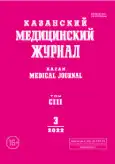Микроструктурные особенности щитовидной железы жителей эндемичной по зобу территории дальневосточного региона
- Авторы: Агеенко К.И.1
-
Учреждения:
- Научно-исследовательский центр «Арктика» Дальневосточного отделения Российской академии наук
- Выпуск: Том 103, № 3 (2022)
- Страницы: 380-389
- Тип: Теоретическая и клиническая медицина
- URL: https://journal-vniispk.ru/kazanmedj/article/view/89605
- DOI: https://doi.org/10.17816/KMJ2022-380
- ID: 89605
Цитировать
Полный текст
Аннотация
Актуальность. В настоящее время актуально использование информативных интеграционных критериев оценки экологического благополучия здоровья населения. Мониторинг морфофункциональных параметров щитовидной железы и её функциональных индексов у жителей различных регионов позволяет контролировать степень напряжения адаптационных резервов в ответ на воздействие среды.
Цель. Установление особенностей морфофункционального статуса тиреоидной паренхимы у жителей эндемичной по зобу территории дальневосточного региона.
Материал и методы исследования. Использовано 168 секционных щитовидных желёз без морфологических признаков тканевой патологии. Применены подходы с учётом возрастной периодизации человека, в зависимости от массы железы и коллоидно-эпителиальных отношений тиреоидной ткани (I эпителиальный, II эпителиальный, коллоидный типы желёз). Изучены качественные и количественные характеристики ¬макро- и микроанатомии щитовидной железы.
Результаты. На основании кластерного анализа были выделены три морфологические группы (типа) щитовидных желёз: коллоидный (61,9%), I эпителиальный (33,3%), II эпителиальный (4,7%). При дискриминантном анализе установлены структурные компоненты, определяющие отнесение железы к конкретному типу (гормональный коллоид и интерфолликулярный эпителий). В нормальных по массе железах в равной степени встречаются варианты гистоструктуры коллоидного и I эпителиального типа. Для гипертрофированных желёз характерна морфология коллоидного типа (86,67%), незначительно выражен I эпителиальный тип (13,33%) и практически не встречается II эпителиальный тип. Определено, что в возрастном аспекте ведущим является коллоидный тип.
Вывод. Установлены два фактора — морфологической стабильности и функциональной активности, ¬которые могут быть рассмотрены как информативные маркёры компенсаторно-приспособительных реакций и уровня активности ткани щитовидной железы жителей эндемичной по зобу территории дальневосточного региона.
Полный текст
Открыть статью на сайте журналаОб авторах
Кирилл Игоревич Агеенко
Научно-исследовательский центр «Арктика» Дальневосточного отделения Российской академии наук
Автор, ответственный за переписку.
Email: kir.ageenko@yandex.ru
ORCID iD: 0000-0001-8297-931X
SPIN-код: 1647-5767
канд. биол. наук, научный сотрудник, группа биоэлементологии и функциональной морфологии
Россия, г. Магадан, РоссияСписок литературы
- Lugovaya EA, Averyanova IV. Assessing tension coefficient of body adaptation reserves under chronic exposure to factors existing in Polar regions. Health Risk Analysis. 2020;(2):110–116. doi: 10.21668/health.risk/2020.2.11.eng.
- Максимов А.Л. Современные проблемы адаптационных процессов и экологии человека в приполярных и арктических регионах России: концептуальные подходы к решению. Ульяновский медико-биологический журнал. 2015;(1):131–143.
- Белобородов Г.С., Горбачёв А.Л. Влияние закаливания на функциональное состояние организма. Наука на Северо-Востоке России. Сборник научных трудов преподавателей филиала РГГУ в г. Магадане. Выпуск 4. Магадан; 2011. с. 102–114.
- Хмельницкий О.К. Щитовидная железа жителей Санкт-Петербурга в норме и при патологии. СПб.: Издательский дом СПбМАПО; 2003. 228 с.
- Суханов С.Г., Карманова Л.В. Морфо-физиологические особенности эндокринной системы у жителей арктических регионов Европейского Севера России. Архангельск: Изд-во Северного (Арктического) федерального университета им. М.В. Ломоносова; 2014. 107 с.
- Веремчук Л.В., Андрюков Б.Г., Янькова В.И., Виткина Т.И., Симонова И.Н. Особенности и критерии воздействия климатических факторов на щитовидную железу жителей Владивостока. Здоровье. Медицинская экология. Наука. 2015;(5):15–20.
- Егорова А.И., Гармаева Д.К. Структурная организация щитовидной железы у мужчин коренной и некоренной национальности Республики Саха (Якутия) в зимний период. Бюллетень науки и практики. 2016;(9):47–52. doi: 10.5281/zenodo.154216.
- Кучиева М.Б., Чаплыгина Е.В. Анатомическая изменчивость размеров щитовидной железы. Вестник Кыргызско-Российского Славянского университета. 2020;20(9):172–175.
- Шпаков А.О. Тиреоидная система в норме и при сахарном диабете 1-го и 2-го типов. СПб.: Изд-во Политехнического университета; 2016. 222 с.
- Шипуло Н.Г. Практическое руководство по УЗИ. Москва: Высшая школа; 1995. Кн. 1. 240 с.
- Касаткина Э.П., Петракова В.А., Мартынова М.И., Мельниченко Г.А., Герасимов Г.А. Консенсус. Эндемический зоб у детей: терминология, диагностика, профилактика и лечение. Проблемы эндокринологии. 1999;45(6):29–30. doi: 10.14341/probl199945629-30.
- Суховерхов В.А. Морфофункциональная характеристика щитовидной железы у жителей Северо-Востока СССР в возрастном аспекте. Основные аспекты географической патологии на Крайнем Севере. Тезисы докладов Всесоюзной научной конференции. Норильск; 1976. c. 97–99.
- Горбачёв А.Л., Шуберт Э.Е., Теселкина А.В., Курьянов А.В., Агеенко К.И. Проблема гиперплазии щитовидной железы (региональный аспект). Колыма. 1997;(3):58–62.
- Луговая Е.А., Агеенко К.И. Возрастная динамика микроструктуры щитовидной железы у жителей г. Магадана. Системные механизмы адаптации человека на Севере. Сборник трудов молодых учёных. Магадан: МНИЦ «Арктика» СВНЦ ДВО РАН; 2000. с. 72–87.
- Горбачёв А.Л., Ефимова А.В., Луговая Е.А. Эндемический зоб у детей г. Магадана. Эпидемиология, экологические факторы. Магадан: Изд-во СМУ; 2004. 106 с.
- Сиповский П.В. Материалы к изучению географической патологии щитовидной железы (патоморфология щитовидной железы эндемической по зобу местности предгорья Памира). Ленинград: ВМА; 1946. 331 с.
- Агеенко К.И., Горбачёв А.Л., Шуберт Э.Е. Особенности гистоструктуры щитовидной железы у жителей г. Магадана. Фундаментальные исследования. 2011;(9-2):191–195.
- Балаболкин М.И., Клебанова Е.М., Креминская В.М. Фундаментальная и клиническая тироидология. М.: Медицина; 2007. 816 с.
- Сапарова К.Г., Сальменбаева Г.К., Сартбаева Е.Ж. Индекс Лэнца–Бауэра хирургических больных с заболеваниями щитовидной железы, оперированных в период с 2004–2014 гг. в АО «Санатории Казахстан» Госпиталь МВД. Национальная ассоциация учёных. 2015;(2-8):71–75.
- Хмельницкий О.К. Гистологическая диагностика неопухолевых заболеваний щитовидной железы. Пособие для врачей. Под ред. Г.Б. Ковальского. СПб.; 1999. 56 с.
Дополнительные файлы








